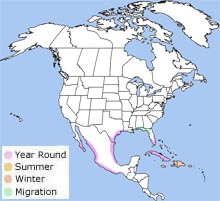Characteristics The reddish egret stands about 2½ feet tall and has a wingspan of about 46 inches. It has a blue-gray body and wings with a reddish neck and head. Adults in breeding plumage have long plumes on their heads and necks. It has long blue legs and a pointed salmon-pink bill with a black tip. It usually holds its neck in an "S" shape when it is in flight and when it is at rest. A white morph of the reddish egret is found in some areas.
Range
 The reddish egret can be found in the Gulf Coast in Texas and Louisiana and in the Gulf and Atlantic coasts of southern Florida The reddish egret is also found in Mexico, the
Caribbean, the coast of northern South America and the West Indies. The reddish egret can be found in the Gulf Coast in Texas and Louisiana and in the Gulf and Atlantic coasts of southern Florida The reddish egret is also found in Mexico, the
Caribbean, the coast of northern South America and the West Indies.
Habitat
The reddish egret can be found in areas with salty or brackish water like
coastal tidal flats, salt marshes and lagoons.
|
|
Diet When the reddish egret hunts for food, it races back and forth in the shallow water, often spreading its wings wide and flapping them. It eats fish, frogs and crustaceans. Sometimes it will curve its wings forward around its body to make a canopy that casts shade on the water. When prey swims towards the shady spot, it quickly snatches them up.
Life Cycle
The reddish egret nests in colonies. The female lays 3 or 4 eggs in a platform of sticks placed in mangroves or low bushes or on the ground. The chicks hatch in 25-26 days and fledge when they are about 45 days old. Both the male and the female build the nest, incubate the eggs and care for the young.
Behavior
Like other egrets and herons, the reddish egret was once hunted for its feathers in the late 1800s and early 1900s and its numbers decreased dramatically. It is now protected and its numbers have increased.
|